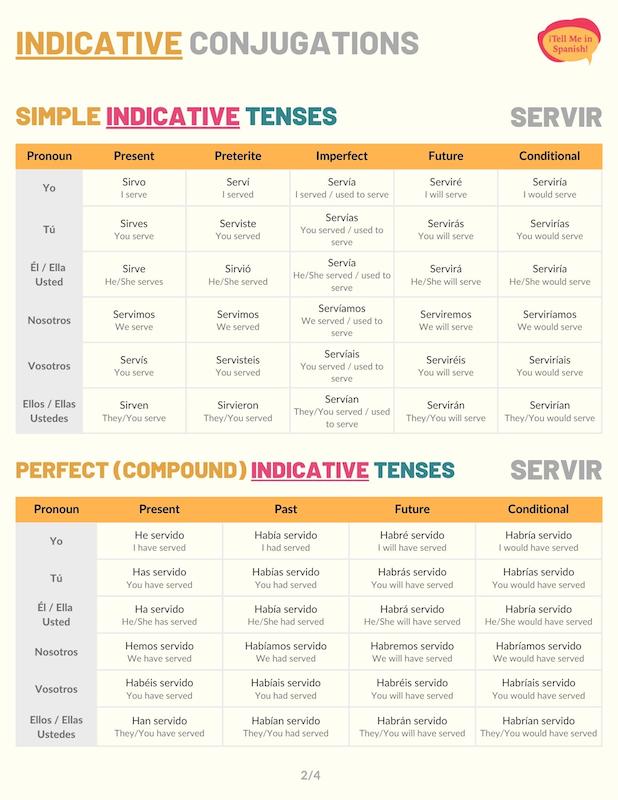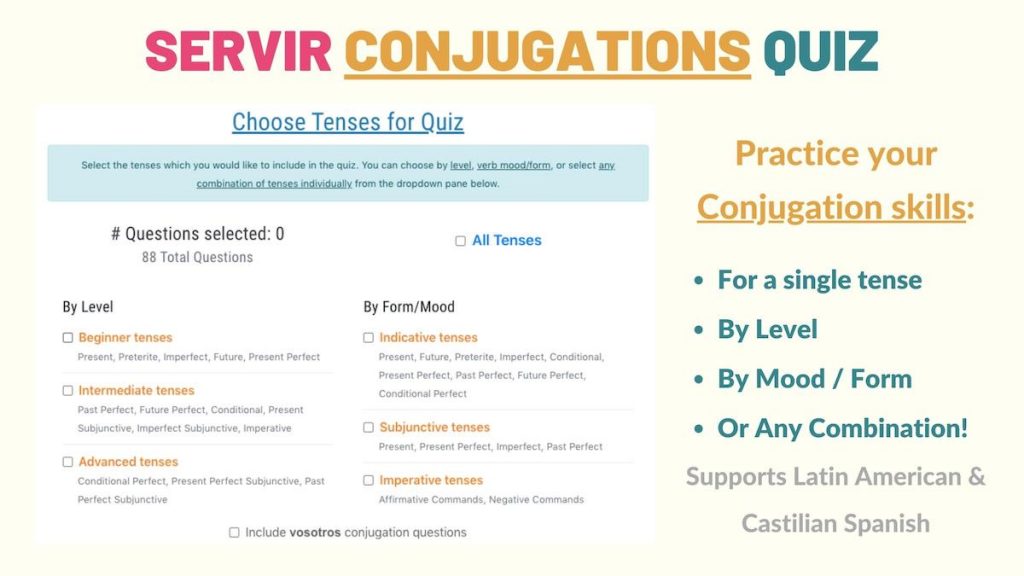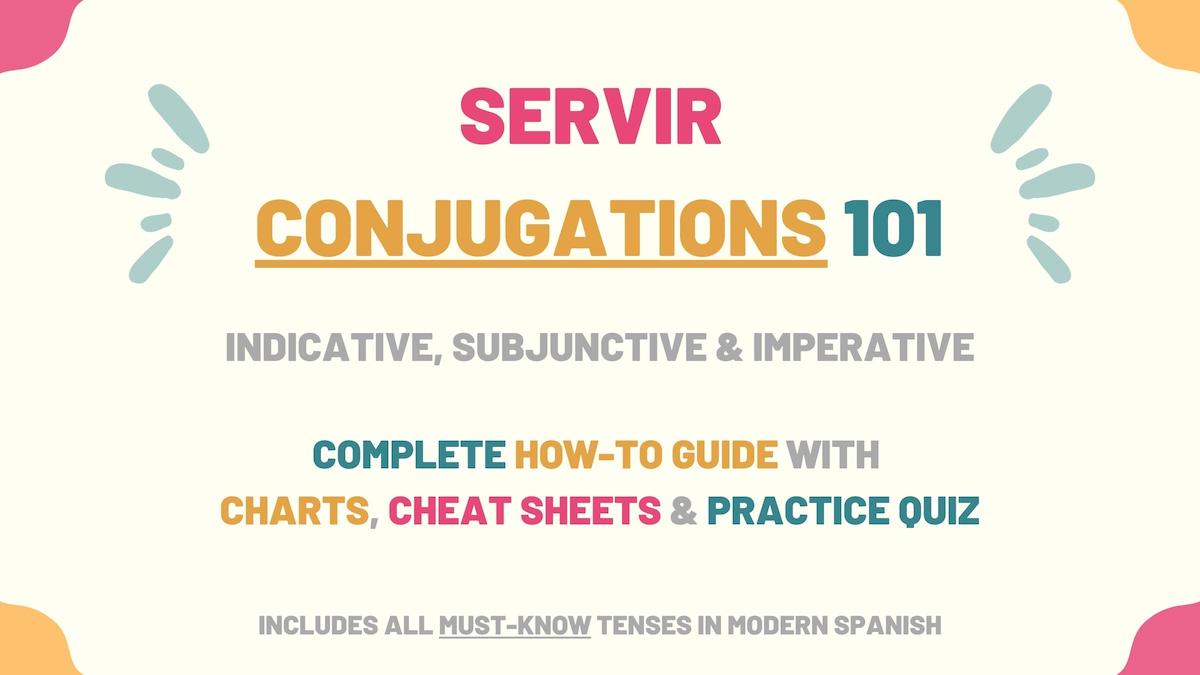Servir conjugation patterns have an E to I stem change in certain tenses. In addition to helping you practice these types of verbs, this word is also commonly used in daily conversations. So, in this guide, you’ll learn how to conjugate servir in Spanish.
- Servir Overview
- Indicative Tenses of Servir Conjugations
- Subjunctive Tenses of Servir Conjugations
- Imperative (Commands) of Servir Conjugations
- Uses & Examples
- Download Servir Conjugation Tables & Uses Cheat sheets
- Servir Conjugation Practice Quiz
Overview of Servir
| Verb Characteristic | Property |
|---|---|
| Verb Type | -IR |
| Irregular | No |
| Infinitive | Servir |
| Gerund (Present Participle) Form | Sirviendo |
| Past Participle Form | Servido |
| Synonyms | Funcionar, usar, sacar, ser. |
Stem Changes: E to I
- Present Indicative: sirv for all subjects except ‘nosotros’ and ‘vosotros’.
- Preterite: sirv for the third-person singular and plural.
- Present Subjunctive: sirv for all subject pronouns.
- Imperfect Subjunctive: sirvie for all subject pronouns.
- Affirmative Imperative: sirv for all subject pronouns except ‘vosotros’.
- Negative Imperative: sirv for all subject pronouns.
Depending on the context, this verb means ‘to serve’, ‘to be good at’, ‘to use as’, ‘to work’, among other applications. The servir conjugation charts below only have one translation. Check the Uses & Meanings section to learn more applications.
Indicative Conjugations of Servir
Present tense
To form servir conjugations in the present tense, you must change the E for an I for all subject pronouns except ‘nosotros’ and ‘vosotros’. The present forms of servir are used to say that a person serves or a device works. For example: Esa chica sirve muy bien.
| Person | Conjugation | Translation |
|---|---|---|
| Yo | Sirvo | I serve |
| Tú | Sirves | You serve |
| Él / Ella Usted | Sirve | He/She serves You (formal) serve |
| Nosotros | Servimos | We serve |
| Vosotros | Servís | You serve |
| Ellos / Ellas Ustedes | Sirven | They serve You (plural) serve |
Preterite tense
Servir’s preterite conjugations only have an E to I stem change for the third-person singular and plural. Conjugate this verb to the past preterite to explain that a device worked or a person served something. For instance: ¿Le serviste vino a tu novia?
| Person | Conjugation | Translation |
|---|---|---|
| Yo | Serví | I served |
| Tú | Serviste | You served |
| Él / Ella Usted | Sirvió | He/She served You (formal) served |
| Nosotros | Servimos | We served |
| Vosotros | Servisteis | You served |
| Ellos / Ellas Ustedes | Sirvieron | They served You (plural) served |
Imperfect tense
When conjugated to the imperfect tense, servir has no stem changes. Use these conjugations to say that a person served or a device used to work. Here is an example: ¿No servían ustedes?
| Person | Conjugation | Translation |
|---|---|---|
| Yo | Servía | I served I used to serve |
| Tú | Servías | You served You used to serve |
| Él / Ella Usted | Servía | He/She served He/She used to serve You (formal) served You (formal) used to serve |
| Nosotros | Servíamos | We served We used to serve |
| Vosotros | Servíais | You served You used to serve |
| Ellos / Ellas Ustedes | Servían | They served They used to serve You (plural) served You (plural) used to serve |
Near future
Ir conjugations + a + servir is how you form the near future tense. These conjugations of servir communicate that a device will work or a person will serve something. For example: ¿Quién va a servir la sopa?
| Person | Conjugation | Translation |
|---|---|---|
| Yo | Voy a servir | I’m going to serve |
| Tú | Vas a servir | You’re going to serve |
| Él / Ella Usted | Va a servir | He/She is going to serve You (formal) are going to serve |
| Nosotros | Vamos a servir | We’re going to serve |
| Vosotros | Vais a servir | You’re going to serve |
| Ellos / Ellas Ustedes | Van a servir | They’re going to serve You (plural) are going to serve |
Future simple tense
Conjugate this verb to the future tense to say that something will work or a person will serve something. For example: Creo que estas pilas no me servirán.
| Person | Conjugation | Translation |
|---|---|---|
| Yo | Serviré | I will serve |
| Tú | Servirás | You will serve |
| Él / Ella Usted | Servirá | He/She will serve You (formal) will serve |
| Nosotros | Serviremos | We will serve |
| Vosotros | Serviréis | You (formal) will serve |
| Ellos / Ellas Ustedes | Servirán | They will serve You (plural) will serve |
Conditional tense
The conditional forms of servir allow you to express that a person would serve or a device would work. Check this example: Si no le hubieras echado agua, tu computadora todavía serviría.
| Person | Conjugation | Translation |
|---|---|---|
| Yo | Serviría | I would serve |
| Tú | Servirías | You would serve |
| Él / Ella Usted | Serviría | He/She would serve You (formal) would serve |
| Nosotros | Serviríamos | We would serve |
| Vosotros | Serviríais | You would serve |
| Ellos / Ellas Ustedes | Servirían | They would serve You (plural) would serve |
Present perfect tense
In Spanish, the present perfect conjugations are formed with haber + past participle. Use these conjugations of servir to explain that a person has served or a car, device, or machine has worked. For example: Este carro no ha servido desde que lo compramos.
| Person | Conjugation | Translation |
|---|---|---|
| Yo | He servido | I have served |
| Tú | Has servido | You have served |
| Él / Ella Usted | Ha servido | He/She has served You (formal) have served |
| Nosotros | Hemos servido | We have served |
| Vosotros | Habéis servido | You have served |
| Ellos / Ellas Ustedes | Han servido | They have served You (plural) have served |
Past perfect
To say that a person had served something before another past action, conjugate the verb servir to the past perfect tense. To form this tense, you must use haber’s imperfect conjugations + servido. Here is an example: Cuando llegué, mi mamá ya me había servido de cenar.
| Person | Conjugation | Translation |
|---|---|---|
| Yo | Había servido | I had served |
| Tú | Habías servido | You had served |
| Él / Ella Usted | Había servido | He/She had served You (formal) had served |
| Nosotros | Habíamos servido | We had served |
| Vosotros | Habíais servido | You had served |
| Ellos / Ellas Ustedes | Habían servido | They had served You (plural) had served |
Future perfect
In Spanish, we conjugate servir to the future perfect tense to convey that someone will have served something or the device would have worked by or before a future time. For instance: A las 10, habremos servido toda la sopa.
| Person | Conjugation | Translation |
|---|---|---|
| Yo | Habré servido | I will have served |
| Tú | Habrás servido | You will have served |
| Él / Ella Usted | Habrá servido | He/She will have served You (formal) will have served |
| Nosotros | Habremos servido | We will have served |
| Vosotros | Habréis servido | You will have served |
| Ellos / Ellas Ustedes | Habrán servido | They will have served You (plural) will have served |
Conditional perfect
The conditional perfect tense forms of servir communicate that something would have served or worked. Check this example: No habría servido de nada que te dijera.
| Person | Conjugation | Translation |
|---|---|---|
| Yo | Habría servido | I would have served |
| Tú | Habrías servido | You would have served |
| Él / Ella Usted | Habría servido | He/She would have served You (formal) would have served |
| Nosotros | Habríamos servido | We would have served |
| Vosotros | Habríais servido | You would have served |
| Ellos / Ellas Ustedes | Habrían servido | They would have served You (plural) would have served |
Progressive tenses
As shown in the following servir conjugation chart, the progressive tenses are formed by using estar conjugated + sirviendo (gerund). Use these forms to explain that someone is serving something or that a device is working.
For example: Mis hijos están sirviendo en el ejército.
| Progressive Tense | Formula | Translation Example |
|---|---|---|
| Present | Estar (present) + sirviendo | I am serving |
| Preterite | Estar (preterite) + sirviendo | You were serving |
| Imperfect | Estar (imperfect) + sirviendo | He was serving |
| Future | Estar (future) + sirviendo | We will be serving |
| Conditional | Estar (conditional) + sirviendo | They would be serving |
Take Note: Like servir, some verbs have stem changes in their present participle form. Since they help you form progressive tenses and other verb phrases, you should get familiar with stem-changing and irregular present participles in Spanish.
Servir Subjunctive Conjugations
A verb conjugated to the subjunctive mood in Spanish allows you to express someone’s requests, hopes, hypotheses, desires, and suggestions. In the coming sections, we’ll review the servir conjugation chart for each of the key subjunctive tenses.
Present subjunctive
The servir present subjunctive conjugation for each pronoun is formed with an E to I stem change. Use this conjugation of servir to request, suggest, or hope someone serves something, or a device works. For instance: Espero que mi suegra no me sirva tanta comida.
| Person | Conjugation | Translation |
|---|---|---|
| Yo | Sirva | I serve |
| Tú | Sirvas | You serve |
| Él / Ella Usted | Sirva | He/She serves You (formal) serve |
| Nosotros | Sirvamos | We serve |
| Vosotros | Sirváis | You serve |
| Ellos / Ellas Ustedes | Sirvan | They serve You (plural) serve |
Present perfect subjunctive
When you conjugate servir to the present perfect subjunctive, you can express any doubts or wishes about whether something already worked or served. Check this example: ¿Crees que le haya servido el consejo que le dimos?
| Person | Conjugation | Translation |
|---|---|---|
| Yo | Haya servido | I have served |
| Tú | Hayas servido | You have served |
| Él / Ella Usted | Haya servido | He/She has served You (formal) have served |
| Nosotros | Hayamos servido | We have served |
| Vosotros | Hayáis servido | You have served |
| Ellos / Ellas Ustedes | Hayan servido | They have served You (plural) have served |
Imperfect subjunctive
In the imperfect subjunctive tense, servir’s conjugation also has an E to I change. In other words, we must use the stem sirvie to form this tense. With these conjugations, you can refer to past recommendations, hopes, or demands related to something work. La verdad, no esperaba que sirviera.
The imperfect subjunctive in Spanish has two sets of ending depending on the dialect you’re learning (Castilian vs Latin American):
Latin American Spanish version
| Person | Conjugation | Translation |
|---|---|---|
| Yo | Sirviera | I served |
| Tú | Sirvieras | You served |
| Él / Ella Usted | Sirviera | He/She served You (formal) served |
| Nosotros | Sirviéramos | We served |
| Ellos / Ellas Ustedes | Sirvieran | They served You (plural) served |
Note: The servir conjugation for vosotros has not been included in this chart since it’s not used in Latin American Spanish.
Castilian Spanish version
| Person | Conjugation | Translation |
|---|---|---|
| Yo | Sirviese | I served |
| Tú | Sirvieses | You served |
| Él / Ella Usted | Sirviese | He/She served You (formal) served |
| Nosotros | Sirviésemos | We served |
| Vosotros | Sirvieseis | You served |
| Ellos / Ellas Ustedes | Sirviesen | They served You (plural) served |
Past perfect subjunctive
Use the past perfect subjunctive forms of servir to explain that something would have worked or a person would have served something if a past condition had occurred. These forms can also be used to express regrets.
For instance: Si no me hubieran servido tanta comida, no me habría quedado tan llena.
| Person | Conjugation | Translation |
|---|---|---|
| Yo | Hubiera servido | I had served |
| Tú | Hubieras servido | You had served |
| Él / Ella Usted | Hubiera servido | He/She had served You (formal) had served |
| Nosotros | Hubiéramos servido | We had served |
| Vosotros | Hubierais servido | You had served |
| Ellos / Ellas Ustedes | Hubieran servido | They had served You (plural) had served |
Servir Imperative Conjugations
We conjugate verbs to the Spanish imperative mood to give commands to people.
Affirmative commands
When it comes to the affirmative imperative, vosotros is the only servir conjugation that doesn’t have an E to I stem change. Use these commands to order someone to serve something. For example: Hija, sírvele más sopa a tu mamá.
| Person | Conjugation | Translation |
|---|---|---|
| Tú | Sirve | Serve |
| Usted | Sirva | Serve |
| Vosotros | Servid | Serve |
| Ustedes | Sirvan | Serve |
Negative commands
Use this verb’s negative imperative forms to order someone not to serve something. As shown in the servir conjugation chart below, these conjugations have an E to I stem change. No le sirvas más comida al bebé.
| Person | Conjugation | Translation |
|---|---|---|
| Tú | No sirvas | Don’t serve |
| Usted | No sirva | Don’t serve |
| Vosotros | No sirváis | Don’t serve |
| Ustedes | No sirvan | Don’t serve |
Meanings of Servir & Examples
Since you already learned servir conjugations in Spanish, in this section, we’ll review how to use this verb. Depending on the context and the class of word you use, this verb means to:
- Serve (direct or indirect object pronouns)
- Be good, serve purpose, or be useful
- Work (when talking about devices)
- Use
[Servir conjugated] + [complement]
¿Por qué se la serviste fría?
Why did you serve it cold?
¿Crees que esta batería sirva?
Do you think this battery works?
Esta máquina sirve para hacer hielo.
This machine is used to make ice.
¿Te sirvió lo que te dije?
The thing I told you was useful?
Take Note: Servir works with indirect object pronouns when expressing that a person is serving something to another or when something is useful to someone. However, direct object pronouns must be used if you’re replacing the thing being served (like soup).
Download Servir Conjugation Charts & Uses Cheat sheet

Servir is one of the most important stem-changing verbs for Spanish beginners to learn. I’ve created a PDF cheat sheet you can download which contains all the servir conjugation tables along with the definitions and example sentences so you can study it at your own pace and refer back to it anytime you need.
Practice Quiz: Servir Conjugation

Congratulations! Now that you’ve seen how to conjugate servir in Spanish, you are ready to master this verb by taking the servir conjugation quiz. This will help you practice working with regular -IR verbs and servir’s stem changes.



